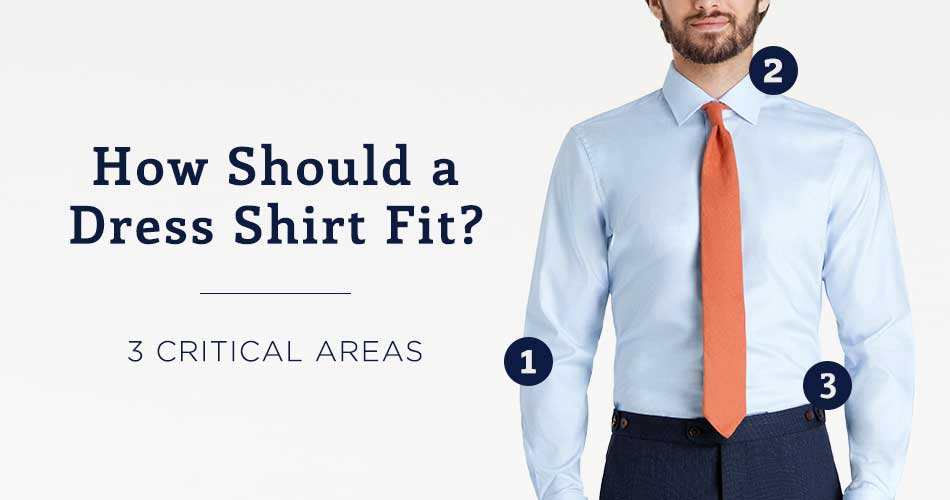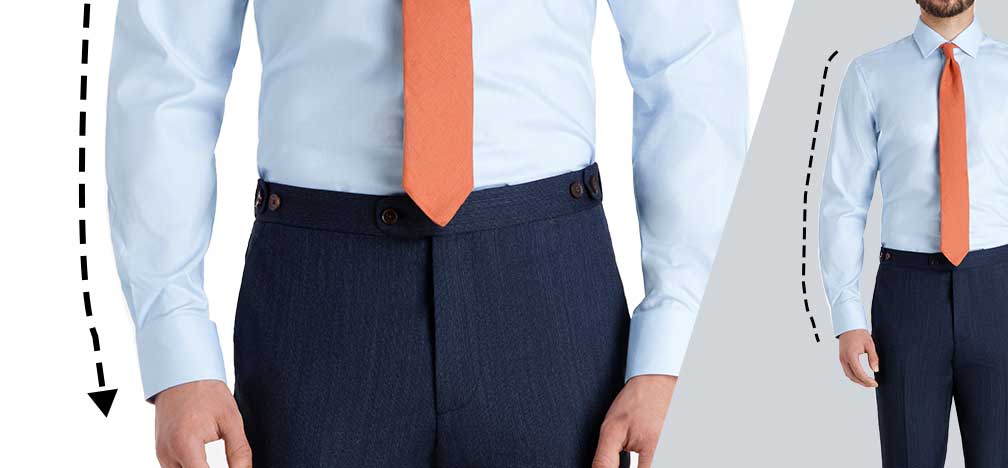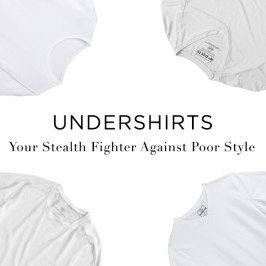How Should a Dress Shirt Fit? — 3 Critical Areas

Learn How a Dress Shirt Should Fit to Look Your Best
Look around your office for a moment. Depending on your workplace, it’s likely you’re seeing at least a few people in dress shirts. And chances are you’re also seeing a lot of excess fabric on those dress shirts and other telltale signs of a bad fit.
It’s not their fault really, they just don’t know better. But if you’re a regular Compass reader, you know that looking your best means wearing clothes that actually fit your body. It’s true. Dress shirts, just like suits, need to fit you properly to look good. The easiest way to nail this is by going custom, but if you must buy off-the-rack, you need to at least brush up on what to look for when it comes to how a dress shirt should fit (it’s for your own good).
The 3 Critical Dress Shirt Fit Areas
For this article, we’re going to focus on the three most common and egregious fit mistakes men tend to make with their dress shirts. There are others (and we may cover them in a future story) but get these three right and you’re 90% of the way there. The three are:
- Excess fabric in the torso
- Sleeves too long for your arms
- Collars that are too loose
These are the areas you need to pay attention to when you’re buying your next dress shirt. Let’s dive into what each problem area looks like so you can master how a dress shirt should fit.

How A Dress Shirt Should Fit Your Midsection

Cue the commercial music – excess fabric around the stomach area is the leading cause of (style) death among people ages 18-55 wearing dress shirts in the United States today.
A proper fitting dress shirt should not have volumes of fabric pouring over the waist of your dress pants. Of course, it should also not be pressed against your body skin tight like a muscle tee. If the shirt is too small, wrinkles will start to form around the buttonholes as the pressure from the tightness mounts and the shirt tries to open up. This problem exacerbates if you sit down frequently as the body distributes more mass around your torso when seated. On the flip-side, if the shirt is too loose, a muffin top will begin to form around the midsection from the excess fabric. If you don’t actually have a muffin top body – congrats, now you look like you do.
If you already have a dress shirt that has way too much fabric, there is good news. Unlike with excess weight, there’s a miracle pill for this. You can ask your tailor to remove the excess fabric on your existing shirts. This is fairly simple compared to other alterations, but one you want to get right, so don’t just say “can you take a little off the stomach?” and bounce. Try the shirt on and have your tailor mark it up (and ideally, pin it) before he/she cuts, because once it’s taken in, letting out a shirt stomach ain’t happening.
How Long Your Dress Shirt Sleeves Should Be

So, how long should dress shirt sleeves be? This is one of the most sought after questions because off-the-rack shirt sleeves that are the perfect length are hard to come by.
Why? Men have a wide range of arm lengths for their bodies. (Just ask the swimmers who competed against Michael Phelps.) Off-the-rack shirts can get you close, but typically at the cost of the right fit somewhere else on the shirt. Your dress shirt sleeves should end at or very close to where your wrists meet your palms. Too short and your shirt sleeves will push too far back if you raise your arms. Too long and your shirt sleeve cuff will begin to fold and pool at the back of your hands when your arms are down sometimes showing a distractingly large amount of shirt cuff when worn with a suit jacket. It’s not a good look.
If you have a favorite shirt with bad sleeve fit, you again have some options. You can pay a tailor to shorten your sleeves to the desired length, though alas, shirt sleeves cannot be lengthened, or you can get a shirt made to your measurements (way better).
A Note About Baggy Sleeves
Aside from length there’s also the billowing arm. Unless the flying squirrel look makes a comeback (just kidding, it was and never will be in style), you’ll want to keep those sleeves trim. Of course, you don’t want to flex those biceps and rip your sleeve either, so as with the stomach, don’t just ask a tailor to taper your sleeves. Have him/her pin it down to be sure you get it Goldilocks right.
How Your Dress Shirt Should Fit at The Neck

A shirt collar that doesn’t fit is not just a pain in the neck, it’ll kill your style. If it’s too small it’ll give you multiple chins every time you turn your head. On the flip side, there’s the single-rose-in-a-vase collar. Your face (we’re being kind) is the rose. Your neck, the lonely stem swimming in the wide gaping maw of a massively oversized collar. You know the look, turn your head and you could practically see the label in the back. This too is unacceptable.
Your dress shirt collar should fit snug against your neck. Snug, not choking-you-out-MMA-style snug. There should be just enough room for you to run two fingers between your collar and your neck when its fully buttoned up. This is important, especially when you’re wearing a tie. Think of the collar of your dress shirt like the waist of your pants. If you have pants that are too big and you put a belt on, the waist will begin to bunch-up together. The same applies for when you secure a tie onto a dress shirt collar that’s too big. The collar will start to deform and crinkle into itself — something to avoid.
Your tailor can move the collar button to make your collar fit a bit tighter or looser but there’s a limit to how much this area can be adjusted before compromising the lines of your placket. For a more significant change, replacing the collar is the way to go. Of course, a tailor may not have an exact match for your existing shirts, so weigh your options carefully.
The Custom Dress Shirt Option
There is one sure fire way to get a perfect fitting dress shirt: get the shirt made just for you. A custom — or as those in the know call it — made to measure dress shirt solves all of the above problems, without you having to go to a tailor for alterations.
The fitted dress shirt you see in these photos was made to each model’s precise measurements. With a quick set of measurements that you can take at home, you can get a perfectly fitted dress shirt regardless if you have a model-like physique or if you’re carrying a few extra lbs. Rebooting your shirt collection with made-to-measure shirts will also let you choose some personal designs like getting the perfect collar style for your face. So if you’ve got some ill-fitting shirts in your closet, grab a measuring tape and go custom today.
Your Next Move:
Like What You See? There's More.
We'll send you style advice and intel for the modern man.




Do you offer bold hues is solid patterns? Something like cobalt blue, emerald green, and cool red?
Also, do you offer fabric swatches? I’m extremely particular with color and texture. =)
Hey there!
If you’re referring to our dress shirts, we currently have more traditional solids. We do have green and red options in checked patterns. As far as fabric swatches, We can send you up to 5! Just send us a message or email us at concierge@blacklapel.com letting us know what you’d like to see and where we should send them.
Hi !!
i am new to the WEBSITE. and awesome tip btw.
anyways, i need some guidance on the topic “only shirt + Tie ” in an convocation planned next week.
i am looking for a look that brings out the contrast in my #3 skin tone with #10 hair color. and that oval face of mine.
any idea on what to wear to look slimmer(coz i am a little overweight) and this is my REUNION u know after 2 months.
i am 19, so i’d like a boyish charm in my outfit and yet a bit formal one.
everything goes for me black , Blue etc.
i avoid sharp bright green and pink which highlight my acne and not so perfect skin.
thanks for any inputs
ciao
You’re on the right track understanding your skin tone and hair color. Match the intensity of your contrast with that of your shirt and tie. The possibilities are limited only by your closet, Damien but our advice is to go with a white shirt and a dark tie. What color(s) is your call. Pattern, also up to you.
As for looking slimmer, the jacket is one of the key ways to appear trimmer. A properly tailored jacket can work wonders for you. But with just a dress shirt, the only way to look slimmer is to actually get slimmer.
Around Black Lapel you’ll find guys who would kill for 19-year-old’s metabolism. Some of us, if we could go back and talk to our 19-year-old selves, would say “Don’t waste the opportunity to be the fittest of your life. Get it in gear.” Okay, end of pep talk, get that shirt and tie and be sure to wear the most important accessory in any man’s wardrobe: confidence.
thanks man.
really appreciate this !!
will look forward to more.
getting slimmer now
thank u so much